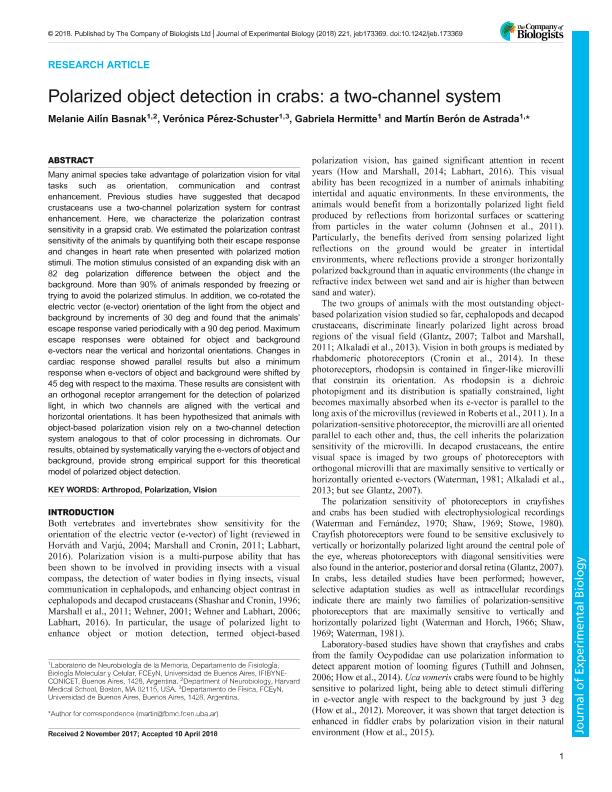Artículo
Polarized object detection in crabs: a two-channel system
Fecha de publicación:
05/2018
Editorial:
Company of Biologists
Revista:
Journal of Experimental Biology
ISSN:
0022-0949
e-ISSN:
1477-9145
Idioma:
Inglés
Tipo de recurso:
Artículo publicado
Clasificación temática:
Resumen
Many animal species take advantage of polarization vision for vital tasks such as orientation, communication and contrast enhancement. Previous studies have suggested that decapod crustaceans use a two-channel polarization system for contrast enhancement. Here, we characterize the polarization contrast sensitivity in a grapsid crab. We estimated the polarization contrast sensitivity of the animals by quantifying both their escape response and changes in heart rate when presented with polarized motion stimuli. The motion stimulus consisted of an expanding disk with an 82 deg polarization difference between the object and the background. More than 90% of animals responded by freezing or trying to avoid the polarized stimulus. In addition, we co-rotated the electric vector (e-vector) orientation of the light from the object and background by increments of 30 deg and found that the animals' escape response varied periodically with a 90 deg period. Maximum escape responses were obtained for object and background e-vectors near the vertical and horizontal orientations. Changes in cardiac response showed parallel results but also a minimum response when e-vectors of object and background were shifted by 45 deg with respect to the maxima. These results are consistent with an orthogonal receptor arrangement for the detection of polarized light, in which two channels are aligned with the vertical and horizontal orientations. It has been hypothesized that animals with object-based polarization vision rely on a two-channel detection system analogous to that of color processing in dichromats. Our results, obtained by systematically varying the e-vectors of object and background, provide strong empirical support for this theoretical model of polarized object detection.
Palabras clave:
Vision
,
Polarized light
,
Arthropod
Archivos asociados
Licencia
Identificadores
Colecciones
Articulos(IFIBYNE)
Articulos de INST.DE FISIOL., BIOL.MOLECULAR Y NEUROCIENCIAS
Articulos de INST.DE FISIOL., BIOL.MOLECULAR Y NEUROCIENCIAS
Citación
Basnak, Melanie Ailin; Pérez Schuster, Verónica; Hermitte, Gabriela; Berón de Astrada, Martín; Polarized object detection in crabs: a two-channel system; Company of Biologists; Journal of Experimental Biology; 221; 5-2018; 1-11
Compartir
Altmétricas




